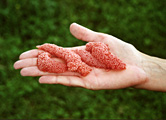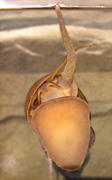Ampullariidae
| Ampullariidae Temporal range:
| |
|---|---|

| |
Spike-topped apple snail
Pomacea bridgesii | |
| Scientific classification | |
| Domain: | Eukaryota |
| Kingdom: | Animalia |
| Phylum: | Mollusca |
| Class: | Gastropoda |
| Subclass: | Caenogastropoda |
| Order: | Architaenioglossa |
| Superfamily: | Ampullarioidea |
| Family: | Ampullariidae J. E. Gray, 1824[2] |
| Diversity[1][3] | |
| 105–170 freshwater species; 9 genera; more than 150 nominal species | |
| Synonyms | |
|
Pilidae | |
Ampullariidae, whose members are
Systematics and taxonomy
Ampullariidae belongs to the superfamily
Genera
Ampullariidae are probably of
There are nine extant[1] genera in the family Ampullariidae:
- Subfamily Ampullariinae Gray, 1824
- tribe Ampullariini
- Ampullaria Lamarck, 1799 – type genus of the subfamily Ampullariinae.,[5] This genus is not treated as a valid extant genus Ampullariidae and is considered a synonym of Pila Röding, 1798 .[1] nomenclatorical details about Ampullaria
- Forbesopomus Bequaert & Clench, 1937
- Lanistes Montfot, 1810[1][5]
- Pila Röding, 1798[1][5]
- tribe Sauleini
Afropominae
- Afropomus Pilsbry & Bequaert, 1927[1] – type genus of the subfamily Afropominae,[5] with the only species Afropomus balanoidea (Gould, 1850).[9]It is treated by WoRMS as belonging to the subfamily Ampullariinae.
- Subfamily Pomaceinae Starobogatov, 1983
- Asolene d'Orbigny, 1838[1]
- Felipponea (Dall, 1919)[1]
- Marisa J. E. Gray, 1824[1]
- Pomacea Perry, 1810[1][5]
- Unassigned to a subfamily
- † Carnevalea Harzhauser & Neubauer, 2016[10]
- † Doriaca Willmann, 1981[11]
- † Euphepyrgula G.-X. Zhu, 1980
- † Mesolanistes Yen, 1945
- † PictaviaCossmann, 1925
- Pomella Gray, 1847:[1] synonym of Pomacea Perry, 1810
- † Pseudoceratodes Wenz, 1928[12]
- † Sudanistes Harzhauser & Neubauer, 2017[12]
- Synonyms
- Effusa Jousseaume, 1889: synonym of Pomacea Perry, 1810 (junior synonym)
- PomellaGray, 1847: synonym of Pomacea Perry, 1810
- Ampullaria Lamarck, 1799: synonym of Pila Röding, 1798
- Ampullarius Montfort, 1810: synonym of Pila Röding, 1798 (invalid: unjustified emendation of Ampullaria)
- Ampulloidea d'Orbigny, 1841: synonym of Asolene d'Orbigny, 1838 (unnecessary substitute name for Asolene)
- † Ampullopsis Repelin, 1902 : synonym of Pila Röding, 1798 (junior subjective synonym)
- Ceratodes Guilding, 1828: synonym of Marisa (gastropod) Gray, 1824 (junior objective synonym of Marisa)
- Subfamily Lanistinae Starobogatov, 1983: synonym of Ampullariidae Gray, 1824
- Leroya Grandidier, 1887: synonym of Lanistes Montfort, 1810
- Limnopomus Dall, 1904: synonym of Pomacea Perry, 1810
- Meladomus Swainson, 1840: synonym of Lanistes Montfort, 1810
- Pachychilus Philippi, 1851: synonym of Pila Röding, 1798 (unjustified emendation of Pachylabra)
- Pachylabra Swainson, 1840: synonym of Pila Röding, 1798 (unnecessary nom. nov. pro Pachystoma Guilding, 1828)
- Pachystoma Guilding, 1828: synonym of Pila Röding, 1798
- Pomus Gray, 1847: synonym of Pila Röding, 1798
- Tribe Sauleini Berthold, 1991: synonym of Ampullariidae Gray, 1824
- Turbinicola Annandale & Prashad, 1921: synonym of Pila Röding, 1798
Distribution
The genera Asolene, Felipponea, Marisa, and Pomacea are New World genera that are native to South America, Central America, the West Indies and the Southern United States.[1] The genera Afropomus, Lanistes, and Saulea are found in Africa.[1] The genus Pila is native to both Africa and Asia.[1]
Ecology
Apple snails are exceptionally well adapted to tropical regions characterized by periods of drought alternating with periods of high rainfall. This adaptation is reflected in their life style; they are moderately amphibious.[13] They have an operculum which enables the snail to seal the shell entrance to prevent drying out while they are buried in the mud during dry periods.
One of the more typical adaptations of apple snails is branchial respiration. The snail has a system comparable to the gills of a fish (at the right side of the snail body) to breathe under water as well as a lung (at the left side of the body) to respire air. This lung/gill combination expands the action radius of the snail in search for food. It is part of the snail's natural behaviour to leave the water when the food supply below the surface becomes inadequate.

Several apple snail genera (Pomacea, Pila and Asolene/Pomella) deposit eggs above the waterline in calcareous clutches and can be recognized by the light pink color they resemble.[14] This remarkable strategy of aquatic snails protects the eggs against predation by fish and other aquatic inhabitants. Another anti-predator adaptation in the apple snail genera Pomacea and Pila, is the tubular siphon, used to breathe air while submerged, reducing vulnerability to attacking birds. The apple snail's usual enemies are the birds limpkin and snail kite.
Apple snails inhabit various
Human use
As a common aquarium animal

Apple snails are popular aquarium pets because of their attractive appearance and size.[citation needed] When properly cared for,[clarification needed] some apple snail species can reach 15 cm (5.9 in) diameter.[citation needed] Apple snails include species that are the biggest living freshwater snails on Earth.
The most common apple snail in aquarium shops[
Apple snails are often sold under the name "golden (ivory, blue, black...) mystery snail" and they are given incorrect names like Ampullarius for the genus instead of Pomacea and wrong species names like gigas instead of maculata.[citation needed]
Temperature
The optimal aquarium water temperature for apple snails is between 18 and 28 °C (64 and 82 °F).[citation needed] Apple snails are more active and lively in the higher part of this temperature range. In these higher temperatures, the snails tend to eat, crawl and grow faster.[citation needed] At the lower end of the temperature range, 18 °C or 64 °F, the snails may become inactive.[citation needed]
As a pest
In the 1980s,
Instead of becoming a valuable food source, the introduced snails escaped and became a serious threat to rice production and the native ecosystems. During the 1980s the introduced snails rapidly spread to Indonesia, Thailand, Cambodia,[16] Hong Kong, southern China, Japan and the Philippines.
Hawaii experienced the same introduction of Pomacea for culinary purposes, and its taro industry is now suffering because of it.
Genera Marisa, Pila and Pomacea (except Pomacea diffusa and native Pomacea paludosa) are already established in the US, and are considered to represent a potentially serious threat as a pest which could negatively affect agriculture, human health or commerce. Therefore, it has been suggested that these genera be given top national quarantine significance in the US.[17]
Nevertheless, apple snails are considered a delicacy in several regions of the world, and they are often sold in East and Pacific Asian markets for consumption.
As a bio-control agent
Pomacea and
As food
In
References
- ^ .
- The Philosophical Magazine and Journal63: 274–277. page 276.
- .
- ^ Arthur Farris (2022). Apple Snail vs Mystery Snail. Article from Aquatic Eden accessed at https://www.aquatic-eden.com/apple-snail-vs-mystery-snail/ on 2023-07-12
- ^ ISSN 0076-2997.
- )
- ^ "Ampullariidae Gray, 1824". WoRMS. Retrieved 19 May 2022.
- .
- ISBN 0-7484-0026-5.
- ^ Neubauer, Thomas A. (2017). Doriaca Willmann, 1981 †. In: MolluscaBase (2017). Accessed through: World Register of Marine Species at http://www.marinespecies.org/aphia.php?p=taxdetails&id=820477 on 2017-11-23
- ^
- ^ Yusa, Yoichi (2007-12). "Causes of variation in sex ratio and modes of sex determination in the Mollusca—an overview*". American Malacological Bulletin. 23 (1): 89–98. doi:10.4003/0740-2783-23.1.89. ISSN 0740-2783. Check date values in: |date= (help)
- ^ Albrecht, E. A., N. B. Carreno, and A. Castro-Vazquez. "A quantitative study of copulation and spawning in the South American apple-snail." Veliger 39.2 (1996): 142–147.
- ISSN 0967-0874.
- ^ Jahn G. C.; Pheng S.; Khiev B.; Pol C. (1998). "Pest potential of the golden apple snail in Cambodia". Cambodian Journal of Agriculture. 1: 34–35.
- ^ Cowie R. H., Dillon R. T., Robinson D. G. & Smith J. W. (2009). "Alien non-marine snails and slugs of priority quarantine importance in the United States: A preliminary risk assessment". American Malacological Bulletin 27: 113–132. PDF Archived 16 June 2016 at the Wayback Machine.
- ]
Further reading
- Baldia JP, Pantastico JB (1991). "Environmental impact of the golden snail (Pomacea sp.) on rice farming systems in the Philippines". Wallaceana. 65: 14–6.
- Bieler R (1993). "Book Review (Vergleichende anatomie ... Berthold, T, 1991) and Cladistic Re-analysis". The Veliger. 36 (3): 291–7.
- Cazzaniga NJ (April 2002). "Old species and new concepts in the taxonomy of Pomacea (Gastropoda: Ampullariidae)". Biocell. 26 (1): 71–81. PMID 12058383.
- Cowie RH (2001). "Can snails ever be effective and safe biocontrol agents?". International Journal of Pest Management. 47 (1): 23–40. S2CID 51510769.
- McClary A (1962). "Surface inspiration and ciliary feeding in Pomacea paludosa (Prosobranchia: Mesogastropoda: Ampullariidae)". Malacologia. 2 (1): 87–104.
- Meenakshi VR (1956). "Physiology of hibernation of the apple-snail Pila virens (Lamarck)". Current Science. 10: 321–3.
External links
- Applesnail website
- Apple Snail in Thailand [1]
